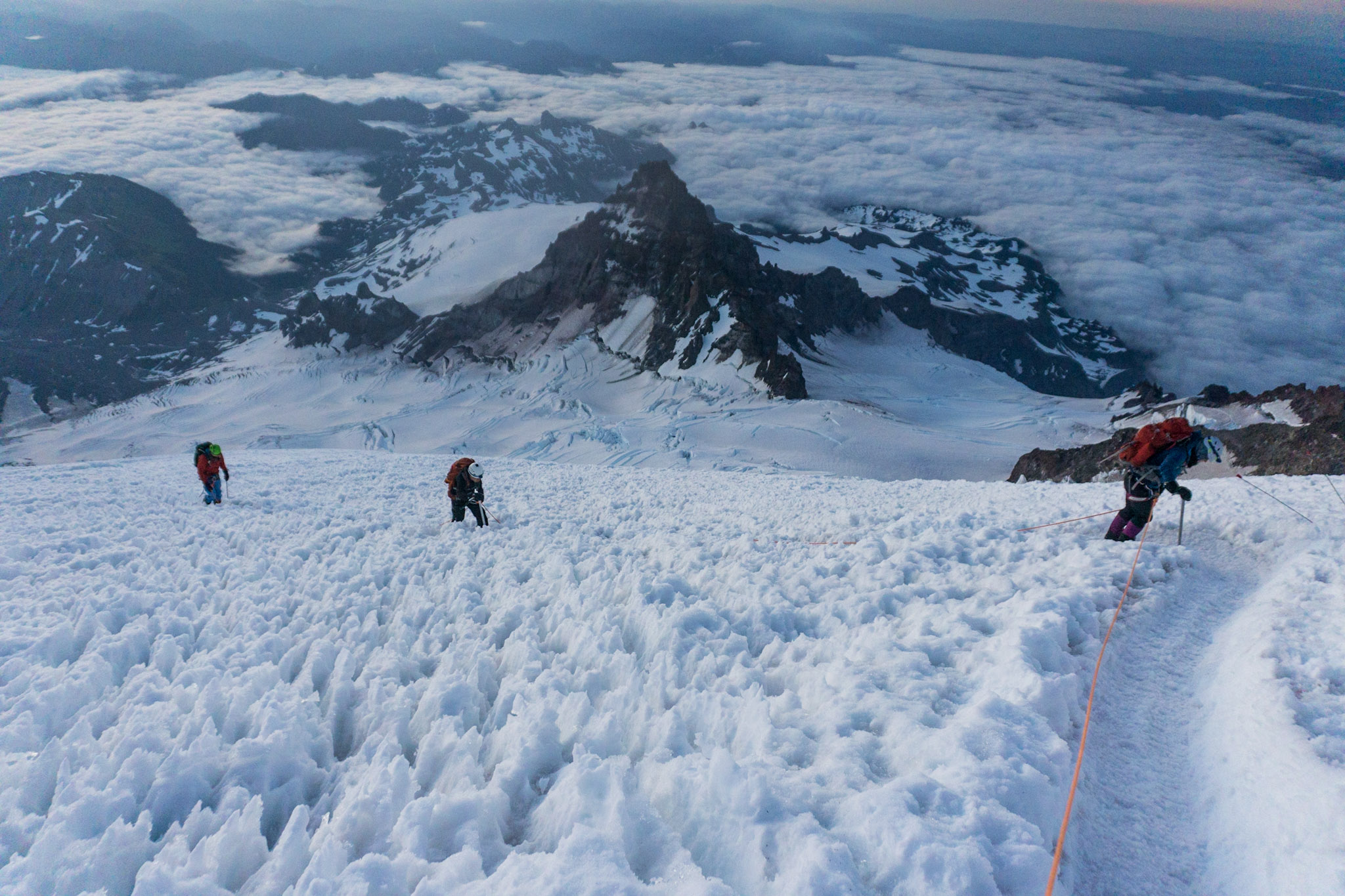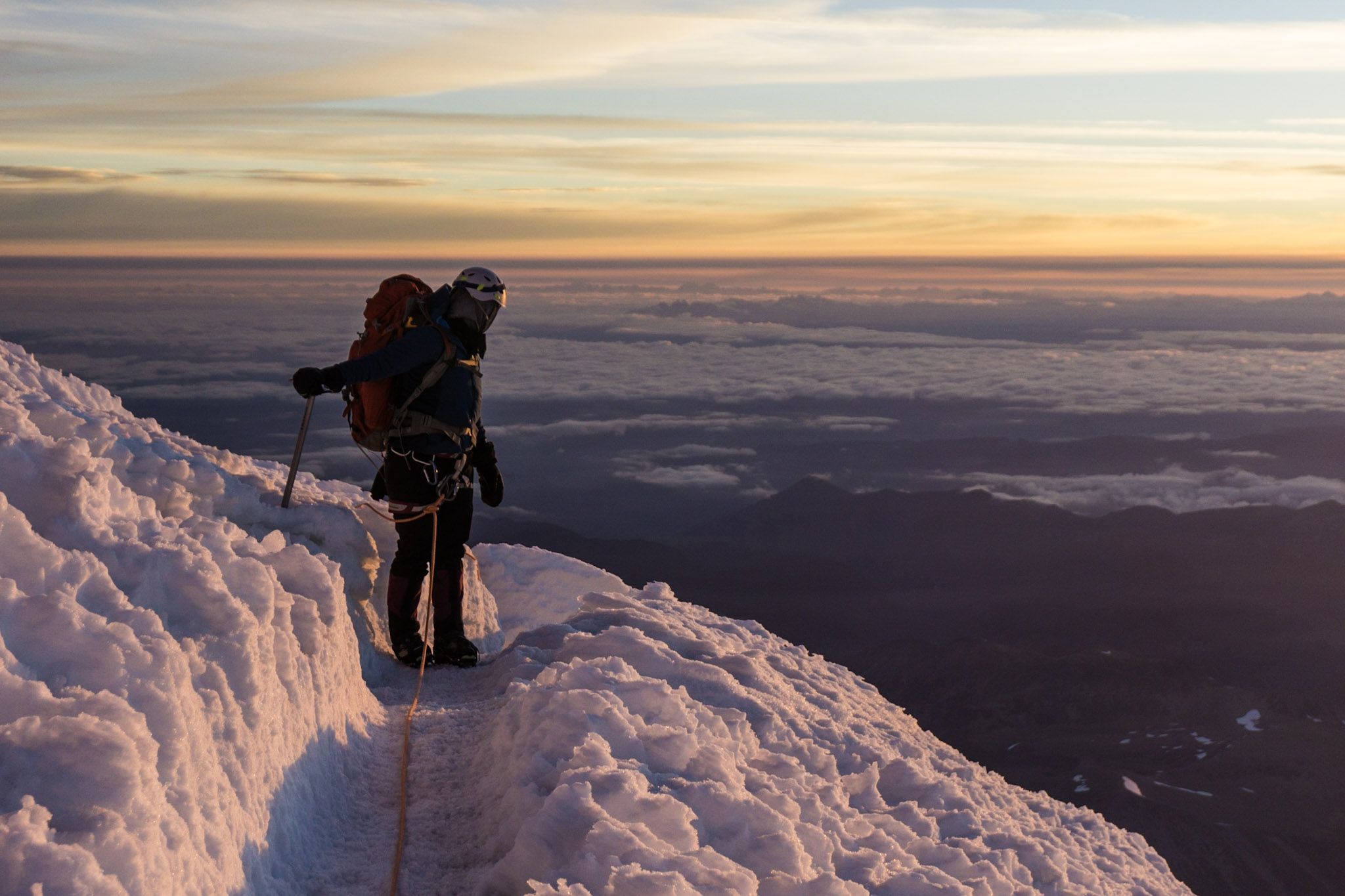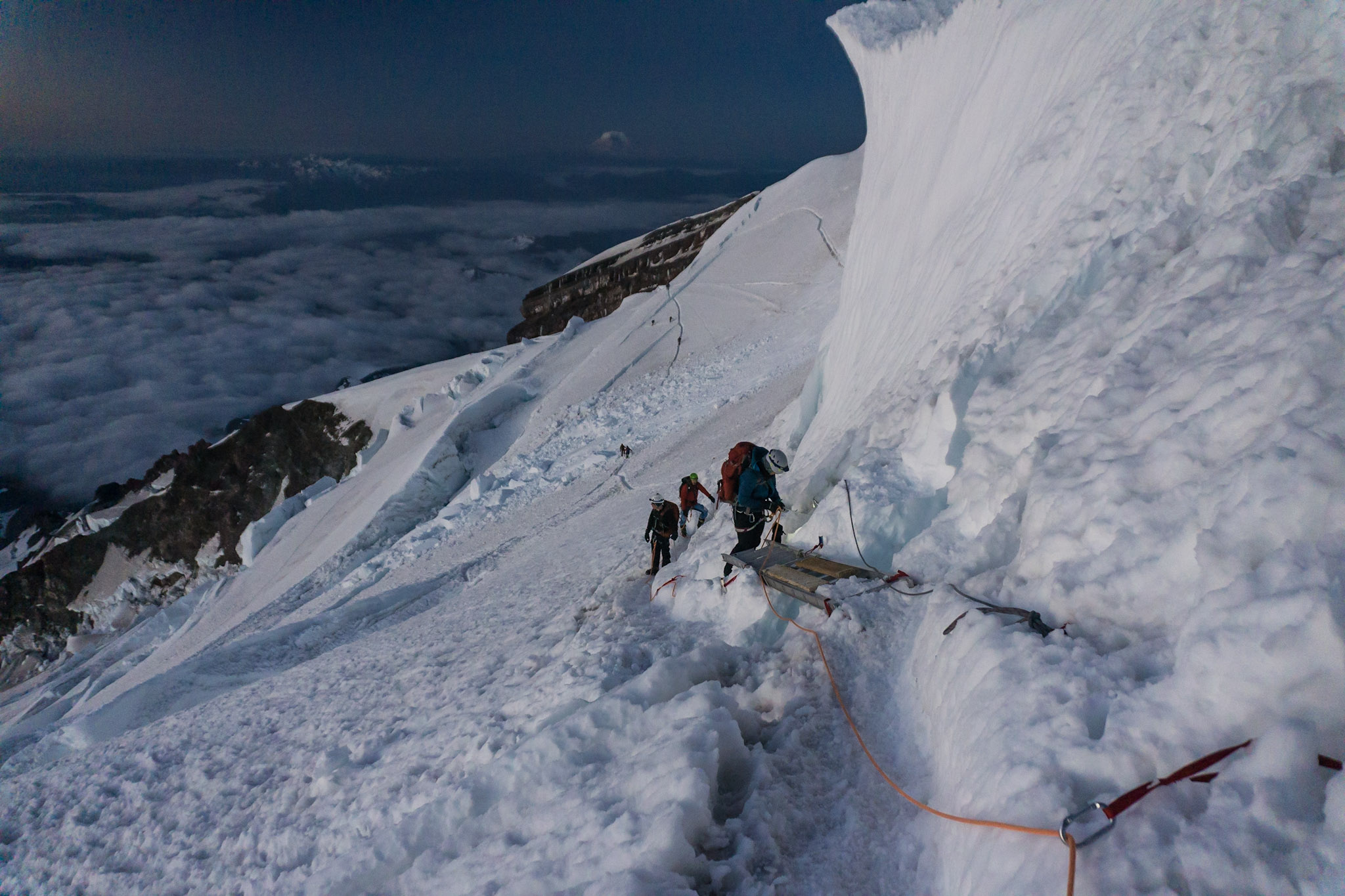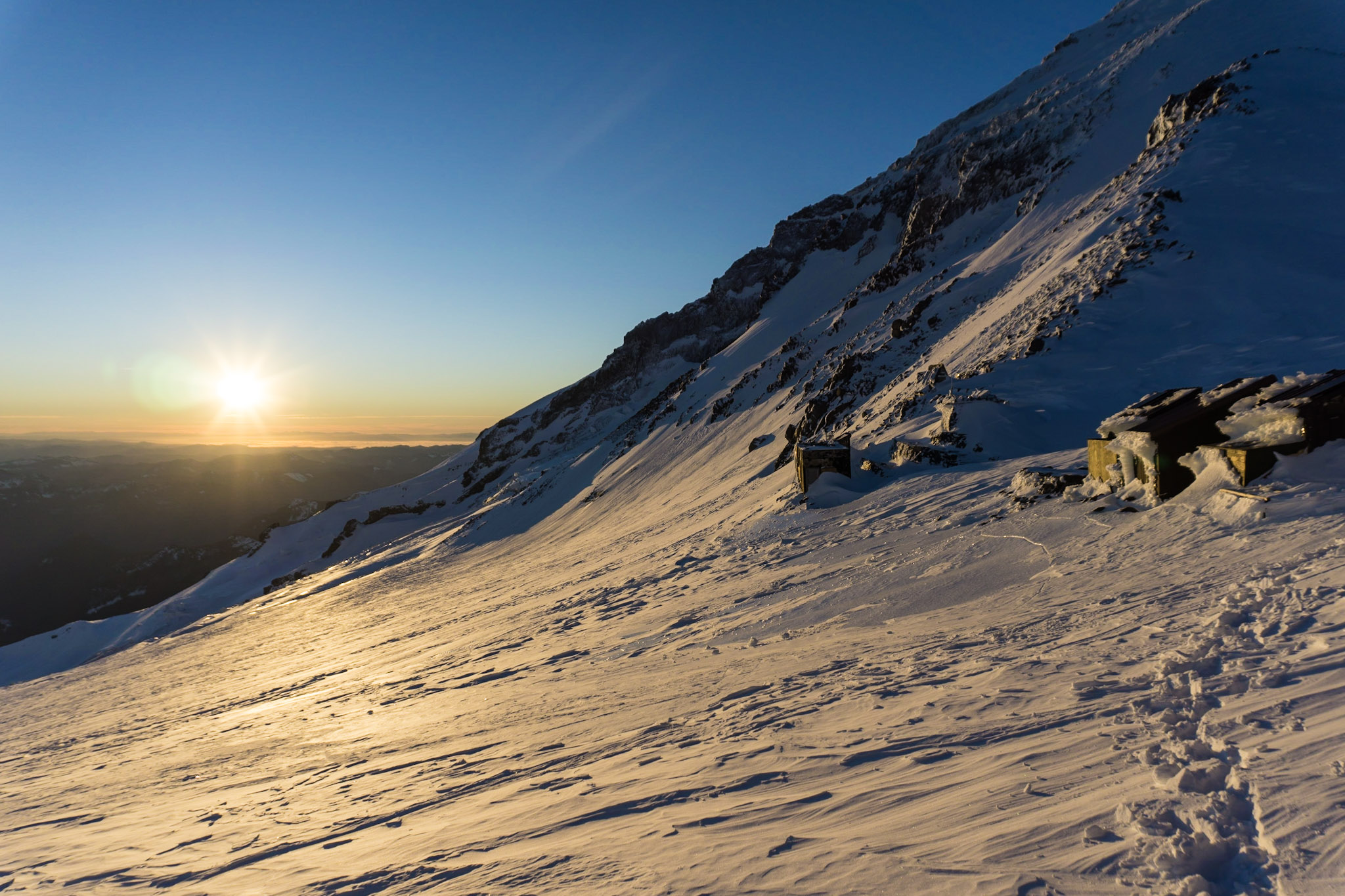Many an aspiring mountaineer has envisioned a journey to climb Mount Rainier in Washington; as a fantastic daydream, a lifelong objective, or even a training step towards larger mountains worldwide. The mountain is certainly a worthy goal, as the fifth highest peak (14,410 ft) in the continental United States as well as the most glaciated mountain in the union outside of Alaska.
There is little question as to why we would want to put ourselves on the top of it, but it may be a daunting feat to consider for those who are only familiar with the relatively small and benign Appalachians and Adirondacks. To help set a course, here are some areas to focus on while training in the Northeast.

1. Determine Your Tactics
The first area to consider is the plan of attack. This will inform the rest of your training moving forward. Will you try and climb in one day so you can move “fast and light?” Maybe a more traditional attempt over two or three days? Keep the group size small or go for safety in numbers? Which route will you try to climb? There are many ways to climb the mountain, and each has its own challenges and advantages. Generally, people will choose to climb the Disappointment Cleaver (DC) route over the course of a few days, as this is considered the “easiest” way up the mountain.
2. Build Up Your Fitness
To climb the DC you will need a high level of physical fitness. Heavy loads as well as the toils of moving through snow and loose rock add up to quite the workout over the course of your climb. The problem in the Northeast is that there is nothing that comes close to the scale of Rainier nearby; the closest options being Mount Washington and Mount Katahdin, both less than half the size of Rainier. Furthermore, living further away from the mountains in more urban areas presents yet another barrier. That being said, use what you have, and don’t be afraid to get creative.

3. Get Heavy
No matter where you live, you can carry heavy packs. Expect to train up to a 45- to 60- pound backpack, and hopefully you will be pleasantly surprised when your climb starts. Use barbell plates, water jugs, and anything else laying around.
4. Don’t Forget the Feet
The most common surprise for people climbing big mountains is how heavy boots, snowshoes, and crampons are. As the old adage goes, “every pound on your feet is like five on your back.” Don’t limit yourself by only training in trail running shoes. Either train in your boots if you have them, or add ankle weights to simulate the heavier footwear.
5. Plan Some Big Days
Mountain climbing is often about the slow and steady pace. Mount Rainier, by most routes, is roughly 10,000 feet from the parking lot to summit, meaning you’ll likely have two 5000-foot days back to back. Be sure to train for endurance as well as strength, so that you won’t be bonking halfway into your 13-hour summit day. Think about training strength in a gym or around home, and take the endurance to the hills (or the stairs). If you’re feeling fit go for a Presidential Range traverse or Pemigewasset Loop hike.

6. Practice in Bad Conditions
Once again, mountain climbing is hard work. Don’t expect for things to go perfectly or even to go well at all on your climb. What often separates successful mountaineers from unsuccessful ones is resilience in the face of adverse conditions, great difficulty, and physical as well as mental fatigue. Practice getting very uncomfortable in less consequential terrain and see what you can handle. Going above treeline in the Northeast is great training, as you can dip your toes into some seriously bad weather with an easy escape back into the woods.
7. Equipment
It takes a lot of stuff to climb the Disappointment Cleaver. Boots, crampons, axes, rope, tent, jackets, jackets, jackets, you get the idea. Mountain climbing is already an expensive pursuit, but keep in mind that the quality of the equipment that you bring can have a huge effect on your success on the mountain.
Luckily, there are some areas to cut costs, such as renting where it makes sense to do so. There are plenty of outfitters around Rainier who may rent boots, crampons, axes, and other hard goods for your climb. Make sure whatever you rent is in good condition and fits well, and try out different gear at the EMS Climbing Schools around New England and New York. Chat with your local EMS Climbing School guides if you have questions.

8. Master the Skills
Mount Rainier features some unique terrain that you won’t find back East. Know how to travel through it efficiently and safely by practicing some specialized skills.
Glaciers
While a climb up the DC is more like a hike than a climb, there is plenty of difficulty in crossing the different glaciers on the mountain safely. Training for traveling in rope teams, routefinding, and crevasse rescue is all critical to managing your risk as well as that of your partners. With no glaciers in the Northeast the next best thing is to hire a guide to help with the mechanics of glacier travel or do your research and find some snow to play “pretend” in.
Movement
The mountaineer’s first line of defense against accidents is movement skills. If you are competent and efficient on your feet, then the rest of the climb becomes easier and safer. Practice moving in steep, firm snow, as well as uneven, loose rocky terrain in crampons and boots. Additionally, learn and practice the self arrest, in case you or a teammate start to fall on the snow. All of this can be done anywhere, so long as there is enough snow.
Winter Camping
If you are sleeping on the mountain you will need to make secure and efficient camps in the snow. There is an art to setting up tents securely and comfortably on the mountain, and troubleshooting campsite problems in bad weather is a crucial skill. Cooking on the mountain is also a challenge, and fluency with your cook system will pay off in dividends on your climb.
Navigation
If you can’t find your way on the mountain, then you can easily turn a fun trip into a dangerous and epic ordeal. Learn how to stay on track and navigate in whiteout conditions before you find yourself lost inside the “ping-pong ball.” In the Northeast there are almost always trees around (unlike high on Rainier) so spend time in alpine terrain to help simulate difficult navigation conditions.

9. Practice Self Care
Making it fun is just as important as anything else, so knowing how to take care of yourself in the harsh environment of Rainier is critical.
Winter Living
Big mountains are some of the least hospitable environments for humans out there, and even with advanced equipment and good fitness it is hard to live up high. Learn how to manage cold, wet feet, and your cold, wet sleeping bag, and generally the living conditions on a snowy mountain.
Nutrition
Expect to be burning a lot of calories on the mountain. You will be working very hard for a very long time, and having the right fuel can keep your climbing dreams alive. Learn beforehand what food you like and dislike before finding out you hate Gu packets when that’s all you have left. Don’t skimp on the tasty treats like potato chips, candy bars, and other things that make your mouth water.
Altitude
Trips to high places can make for a wicked hangover for people accustomed to life around sea level, and unfortunately there isn’t much to be done about altitude preparation besides spending lots of time up high, hydrating, and acclimating. Altitude also has an effect on appetite, so bring easy-to-eat food that you can still stomach when you feel crummy.
Sun Protection
The popular climbing season for the Disappointment Cleaver is in the summer, and you will find that spending a lot of time exposed on the snow in the hot sun can take a heavy toll on your well being. Protect yourself from the sun with sunblock, high-quality sunglasses, hats and hoods, and SPF rated lip balm.
As always, a great step in training is to work with qualified instructors. For help in your training and education, get in touch with your local EMS Climbing School.
Sean Coit
Sean is a New Hampshire native who can be found looking for remote ski lines and climbing objectives when not working for the EMS Climbing School. Talking about gear makes up a large percentage of Sean’s conversations, and occasionally those ramblings will make their way into print.
Related Posts
April 2, 2024
10 Tips for Mountain Biking Etiquette During Mud Season
One rough spring could ruin the…




